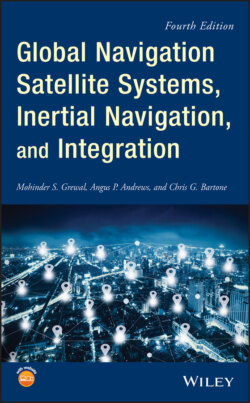Читать книгу Global Navigation Satellite Systems, Inertial Navigation, and Integration - Mohinder S. Grewal - Страница 142
3.6.2.3 Gimbaled Navigation Propagation
ОглавлениеThe signal flowchart in Figure 3.23 shows the essential navigation signal processing functions for a gimbaled INS with inertial sensor axes aligned to locally level coordinates, where
Figure 3.22 Outputs (in angular brackets) of simple strapdown INS.
is the specific force (i.e. the sensible acceleration, which does not include gravitational acceleration) applied to the host vehicle.
is the instantaneous inertial rotation rate vector of the host vehicle.
denotes a specific force sensor (accelerometer).
denotes the ensemble of gimbal angle encoders, one for each gimbal angle. There are several possible formats for the gimbal angles, including digitized angles, three‐wire synchros signals, or pairs.
denotes an inertial rotation sensor (gyroscope).
Position is the estimated position of the host vehicle in navigation coordinates (e.g. longitude, latitude, and altitude relative to sea level).
Velocity is the estimated velocity of the host vehicle in navigation coordinates (e.g. east, north, and vertical).
Attitude is the estimated attitude of the host vehicle relative to locally level coordinates. For some three‐gimbal systems, the gimbal angles are the Euler angles representing vehicle heading (with respect to north), pitch (with respect to horizontal), and roll. Output attitude may also be used to drive cockpit displays such as compass cards or artificial horizon indicators.
Accelerometer Error Compensation and Gyroscope Error Compensation denote the calibrated corrections for sensor errors. These generally include corrections for scale factor variations, output biases, and input axis misalignments for both types of sensors, and acceleration‐dependent errors for gyroscopes.
Gravity denotes the gravity model used to compute the acceleration due to gravity as a function of position.
Coriolis denotes the acceleration correction for Coriolis effect in rotating coordinates.
Leveling denotes the rotation rate correction to maintain locally level coordinates while moving over the surface of the Earth.
Earth Rate denotes the model used to calculate the Earth rotation rate in locally level INS coordinates.
Torquing denotes the servo loop gain computations used in stabilizing the INS in locally level coordinates.
Figure 3.23 Essential navigation signal processing for gimbaled INS.
Not shown in the figure is the input altitude reference (e.g. barometric altimeter or GNSS) required for vertical channel (altitude) stabilization.
